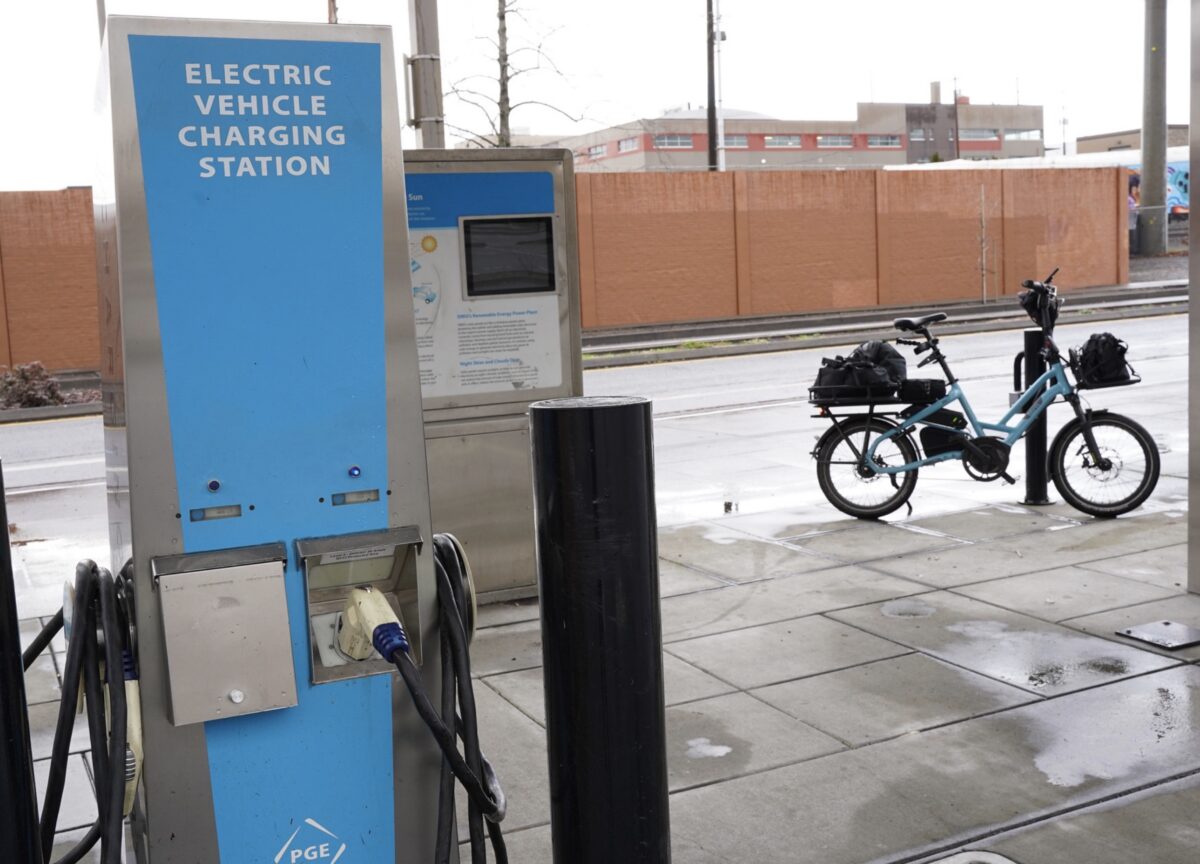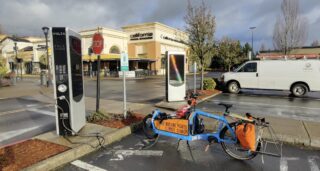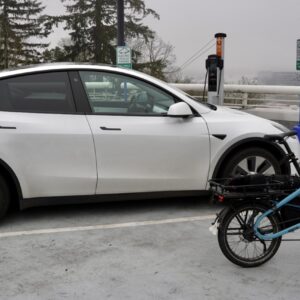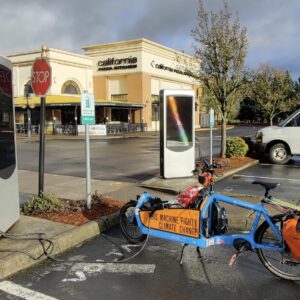
(Photo: Jonathan Maus/BikePortland)
Within the $1.2 billion chunk of change the state of Oregon received from President Biden’s Infrastructure Investment and Jobs Act, (IIJA) $52 million has been designated for electric car charging stations. More funds will be provided for this program through state sources. In total, the Oregon Department of Transportation (ODOT) is committing $100 million over the next five years for electric vehicle charging.
“The Feds set the funding, and they want e-cars.”
— Jillian DiMedio, ODOT
We’re watching closely to see how much — if any — of that money will go toward electric bicycle charging.
The term “electric vehicle” (EV) typically refers only to electric cars, but bicycles are vehicles under Oregon law and if we want to reach the full potential of transportation electrification and bring the benefits of bicycling to more people in the process, we must expand our definition of EVs.
Based on a statement from ODOT released this week, they’re beginning to see the light. In their announcement about the $100 million commitment, the agency said they’re not “ignoring other types of electric vehicles.” “Micromobility (bicycles and scooters) are also going electric… and ODOT will explore opportunities to add micromobility charging,” the press release reads.
When it comes to how they’ll explore these opportunities however, the details are murky. ODOT has a clear game plan for how they’re going to dole out the money to build an electric car charging network; less so for the plan to make sure people can charge their e-bikes and other micromobility devices while out and about.
This is partially because much of red tape around the IIJA funding and the federal government’s requirements to specifically fund electric car charging says ODOT’s Senior Transportation Electrification Analyst Jillian DiMedio. “The Feds set the funding, and they want e-cars especially,” she shared with me in a conversation this morning.
Advertisement
But the focus on electric cars isn’t solely because of federal requirements. The ODOT press release states that the $100 million investment will be focused on cars, SUVs and trucks because “demand is high and the technology is mature.” This statement is sure to ruffle some e-bike enthusiast feathers, considering e-bike demand is actually surpassing that of electric cars, and e-bikes have been around longer than the first modern electric cars.
DiMedio says another reason e-bike charging is lagging is because while access to charging stations is crucial to get around on an e-bike, a lack of public outlets hasn’t been shown to be one of the main barriers to adoption.
“We’re really committed to learning more about this industry, and we want to understand what the key barriers are and the recommended strategies for overcoming them,” DiMedio says. Instead of finding a place to recharge, DiMedio thinks bigger adoption hurdles for would-be e-bikers are safety concerns and cost.
We’ve acknowledged this in our reporting on what’s holding back the e-bike boom, but a lack of public demand for e-bike charging needs shouldn’t be the only data point when the EV charging conversation has never fully welcomed bikes into the mix. If ODOT invests in charging for EVs, they need to be inclusive of more than just cars.

“We recognize electric micromobility as one of our use cases. They really can replace car trips,” DiMedio says. “And education and awareness are a huge part of this. People don’t recognize the capacity.”
As it is now, ODOT is working with private company Electric Vehicle Charging Solutions on upgrades to the charging stations along the West Coast Electric Highway, and these upgrades will include installing new 120 volt outlets for electric bikes and scooters.
DiMedio says they’re also working with Forth on a study about micromobility needs. The last ODOT electrification study didn’t give e-bikes their due, so hopefully this new study will be more insightful into how better to serve e-bike users.
Ultimately, DiMedio says they want to be working from all sides. “Our goal is to electrify everything that moves,” she says.






Thanks for reading.
BikePortland has served this community with independent community journalism since 2005. We rely on subscriptions from readers like you to survive. Your financial support is vital in keeping this valuable resource alive and well.
Please subscribe today to strengthen and expand our work.
As if this isn’t being said by someone in ODOT, who could also be funding infrastructure to address the safety concerns. So frustrating.
I hear you, but to say ODOT doesn’t fund bike infrastructure isn’t really true. They have many millions devoted to bike stuff. It’d definitely not enough and it’s dwarfed by car stuff, but they do technically try and make cycling safer (they’re just not super great at it).
I think this is really not accurate. The Highway division still has more than 3 billion in funding, while safety has about 35 million. Spending 100x more money on state highways than road safety I think it’s fair to say they don’t really care.
In fact, the highway budget increased by 500 million between the two most recent budgets. ODOT absolutely does not care about making cycling safer.
I am absolutely not going to be put in the position of defending ODOT’s funding decisions. This often happens when I try to share a fact or an alternative point of view. Again, I’m not here to defend ODOT and I do not want to get into this debate in this context, I was just pointing something out. Thanks.
It’s amusing that you point out that the highway budget increased by 500 million (as if ODOT somehow materialized the $$$$ out of thin air) when it’s the democratic party of Oregon that controls ODOT’s budget and micromanaged its priorities.
As election day nears I feel a weird mix of sadness and gallows humor watching the people protesting “ODOT’s” highway expansions begging people to vote for the democrats who actually pushed for freeway expansion (e.g. Kotek).
It seems like encouraging public facilities to have public outlets and subsidizing the power of said outlets would be all that was required.
People who want to charge can bring their own chargers for now. The barrier for long-range e-biking is locked outlets as Shawne has shown repeatedly.
Most people are probably going short enough trips that they can charge their car or bike at home and don’t need any public charging. I tend to think this effort gets more airtime than it deserves.
If we really wanted better public charging for cars, requiring credit card payment systems instead of proprietary fobs or smartphone apps would go a long way to making the existing charging network more accessible. Gas stations take cash & credit whereas electric car chargers do not take either in most cases
Given that about a third of car chargers are out of service at any given time, can we expect similar lack of maintenance for bike chargers? Also, will bike chargers have different configurations for different makes of bikes like car chargers have for cars?
Out of curiosity, what sorts of sites should be prioritized for e-bike charging? I mostly see EV charging at grocery stores or gas stations, with a few “destination” chargers like at OMSI. Does it make sense to follow the same pattern for e-bikes?
This is something ODOT needs to find out through a formal study and I hope the Forth study going on helps with it.
IMO there are lots of use cases: I think ODOT should work with Travel Oregon and Cycle Oregon through the Scenic Bikeways Program to identify locations on key sections of popular routes so that we can encourage e-bike tourism trips. I also think there should just be a standard that wherever we have a car charger, there’s also a bike charger. Or the state could create a standard plug that needs to be used that can accept the major bike connectors. There’s a lot we can do when we get into the details, like finding ways to encourage local gov’t to integrate e-bike charging areas into bike parking regulations for multi-family dwellings and office projects, and so on.
FWIW, there is a small-but-significant sentence in the EV charging requirement for all Oregon State Parks (passed in 2021) that it include e-bike charging access. Sometimes it takes a staffer paying attention :).
This is a really interesting idea. I’d love to have one near the bike racks at a grocery store. Also at the beginning/end of trails like the springwater or banks vernonia. gas stations, no thanks. Last thing I need to breathe for an hour is putrid exhaust and unburnt hydrocarbons. A premium bike parking location like the OHSU tram also makes a ton of sense. As do entrances to parks. Steal a single parking space from our free storage collection and plop in a dozen bike parking spaces with the capacity to charge a handful at once.
This isn’t worth investing energy in for the simple reason that ordinary outlets charge bicycles and they rarely go far. One major advantage of bicycles is they go anywhere so chargers in a few areas do nothing. For anyone that needs more, adapters will work fine.
Bike infra needs more lanes and paint, not just optics like this.
Yeah this is just greenwashing really. E-Bikes need lane/road/path infrastructure, not charging infrastructure to encourage adoption. ODOT is either fundamentally misunderstanding how an e-bike is used, or they are purposefully being obtuse for political reasons.
I disagree with both of you. E-bikes absolutely need charging infrastructure IMO. Your arguments remind me of vehicular cycling advocates who fought against bike infra because “cyclists really need to learn to ride” and could just share the road with drivers if they did. I personally have been in positions on e-bike rides where I needed juice and biked past EV charging stations that had nothing for me. That is unfair and makes no sense if we want to encourage cycling. Please don’t be all Stockholm Syndrome yet again with this issue. Perhaps the reason cycling struggles to get to the next level in this country is that whenever folks step up to demand equal treatment as drivers get, there are folks like you to who say “I’m a cyclist and I don’t personally think we need this thing, so it’s a bad idea.”
The problem is this type of infrastructure only helps in truly unusual situations, namely that you just happen to need juice where there is an EV charging station (rare), one of the few plugs is open, and you have hours to wait. In a best case scenario, this only has the potential to help a miniscule part of the cycling population.
For a bike, any outlet is a charging station and they’re everywhere you find people with the added bonus that batteries can typically be removed and carried inside. But you really don’t want to run out of juice because the best practical option in most cases will be to just ride more slowly without assist for the simple reason that it takes too long to get some juice.
ODOT does not care about anyone outside of a car or truck. Just take one look at their budget – if you are spending 60% of your 5 billion dollar budget on highways (re-branded as “Delivery & Operations”) it’s pretty clear where your priorities lay.
Here is the most recent budget for anyone feeling masochistic:
So, there’s another aspect of this that’s challenging. These car charging stations are rigged up to be very high voltage so they can pass a ton of current over the lines without making them too heavy to move. 400 or 800v systems are not uncommon these days, which is how you add (for instance) 100 miles in 20 minutes or whatever it might be.
Ebike chargers that come with the bikes are much less sophisticated. You’re lucky to get 3-4 amps out of them which, when you’re running a 15Ah battery (which is on the small end) means it’s 5 hours from empty to full. Now, when you’re charging your car, you’ve essentially brought your entire living room with you. 4-5 cushy seats, no doubt an infotainment unit from which you can be distracted while remaining immobile. On your ebike, you have nothing of the sort. Most ebikes don’t have a comfortable place to sit, and if they’re just going to stick 110v sockets on car chargers for ebike use, you’re going to be sitting in a puddle of road detritus and bits of car while you wait hours for your bike to charge.
Not to mention the rain. What are the odds they’ll install rain covers over the bike charging area? Also, depending on your battery configuration, it might be unsafe to plug into your battery in the rain.
It’d be lovely if they built something like bus shelters for you and your bike to charge from. But don’t have any faith that anyone who is going to “explore” this has either ridden an ebike to the point where you need to charge it outside the home, or when the weather is less than fair.
Time will tell, but until then I’m on my own.